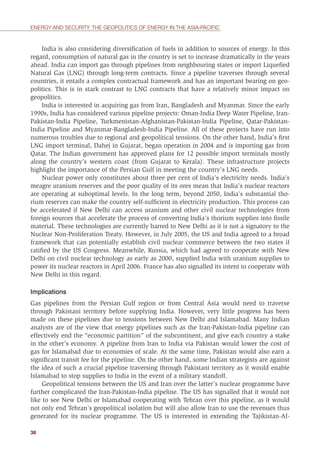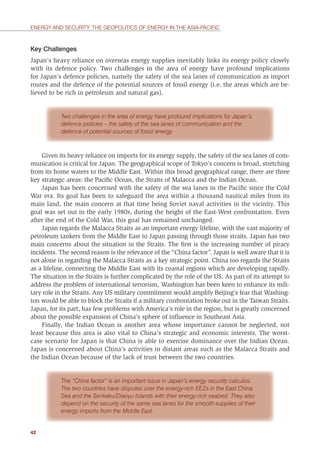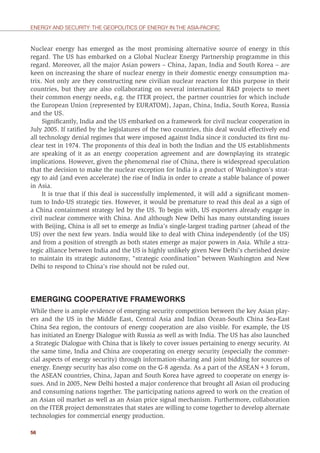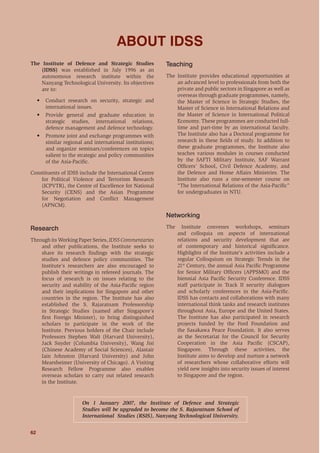This document provides an overview of energy security challenges in Asia and examines the energy profiles and strategies of major countries in the Asia-Pacific region. It finds that all countries are increasingly dependent on foreign energy sources and vulnerable to supply disruptions. Key countries are diversifying their sources of supply but also enhancing their naval and military capabilities to secure strategic waterways. There is a need for greater cooperation on issues like collective stockpiling and development of alternative energy, to help address shared energy security concerns.





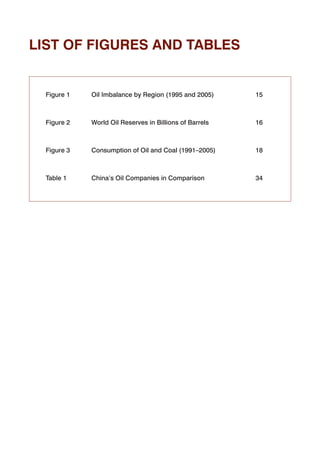





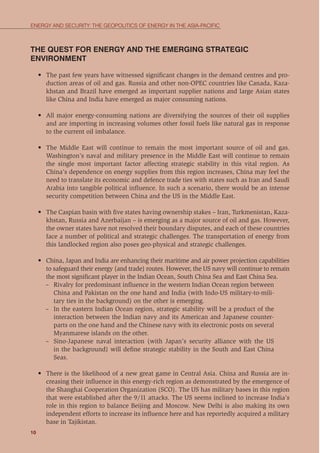
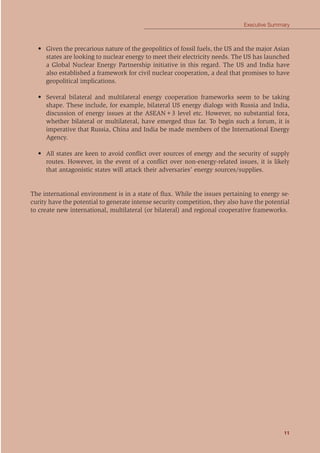


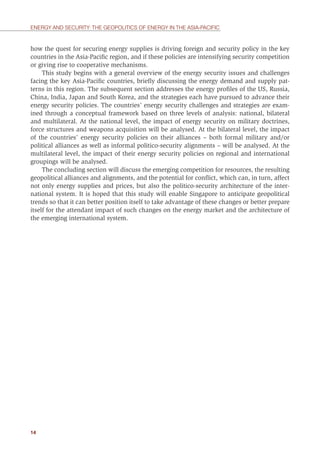









![24
ENERGY AND SECURITY: THE GEOPOLITICS OF ENERGY IN THE ASIA-PACIFIC
Key Challenges
There are two key challenges to US energy security: the vulnerability of the supplier state to
deliberate disruption of its production; and the designs of emerging peer competitors. Cer-
tainly, there is currently less fear among governments that supplier states will use oil as a
political weapon. The oil shocks of the 1970s and 1980s moved governments and industry
to source for supplies beyond OPEC states and to invest in alternative energy resources. If
buyers worry about high oil prices, sellers agonize over severe cutbacks in demand. The in-
ternational market for oil is as competitive as any other industry.
There are two key challenges to US energy security: the vulnerability of the
supplier state to deliberate disruption of its production; and the designs of
emerging peer competitors.
Yet small changes in supply can still result in significant price swings given the inelastic
demand for oil in the short run. This will destabilize the US economy. One worst case sce-
nario posits: if political instability causes Arab OPEC members to disrupt 10 out of the 21.7
million barrels per day that Arab states export to global buyers, crude oil prices will spike
to US$161 per barrel. This will cause the US GDP to drop by roughly five per cent annually,
resulting in a sharp recession.2
Washington has consequently articulated its apprehensions
about unstable oil-rich regimes. Indeed, the 2006 US National Security Strategy identified the
US dependence on “unstable parts of the world” for oil as a security problem.
Washington has also expressed concerns about the energy security policies of emerging
peer competitors like China. Chinese oil deals with Myanmar, Sudan and Iran have irked
US policymakers not only because US companies cannot compete with the Chinese in those
territories where sanctions have been in force, but China’s actions are also undermining
the US sanctions policy toward the states. China’s long-term intentions, which appear to be
to secure oilfields and attempt to deny them to the US, have also generated unease. Again,
the latest National Security Strategy document highlights Washington’s apprehensions about
China’s energy policy and further accuses China of “supporting resource-rich countries with-
out regard to the misrule at home or misbehaviour abroad of those regimes”.
US Energy Security Strategy
With the US economy and its capacity to advance its foreign interests at stake, Washington
has sought to address the threats to its energy security appropriately. The US energy security
strategy has five key elements. These are collectively aimed at reducing American depend-
ence on foreign supplies, and undercutting the ability of potential adversaries from using oil
as a strategic weapon against the US. Ultimately, these initiatives have been pursued to break
“the American addiction to oil”, as President George Bush pronounced in his 2006 State of
the Union address. In numbers, the objective is “to replace more than 75 of our [US] oil im-
ports from the Middle East by 2025”.
2
Gerry L. Perry, “The War on Terrorism, the World Oil Market and the US Economy”,
The Brookings Institution Analysis Paper, no. 7 (24 October 2001; revised, 28
November 2001).](https://image.slidesharecdn.com/energyandsecurity-170324053101/85/Energy-and-security-26-320.jpg)
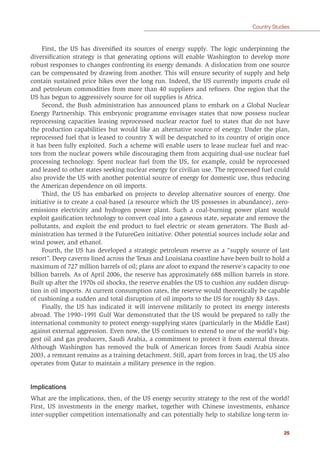
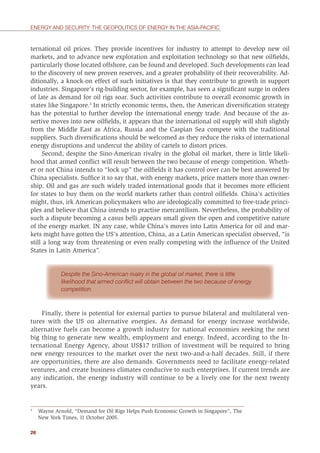
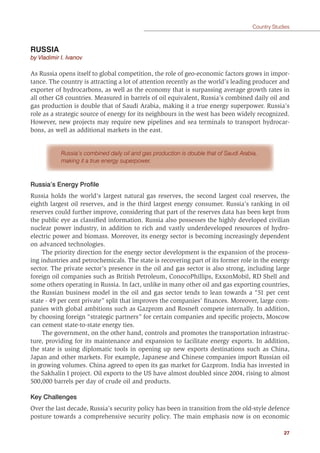
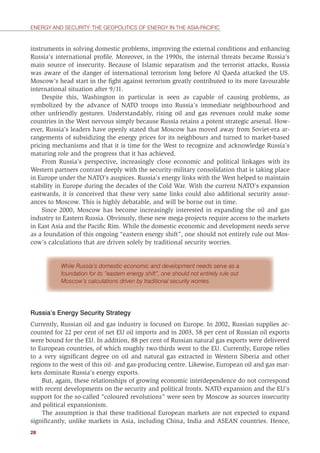

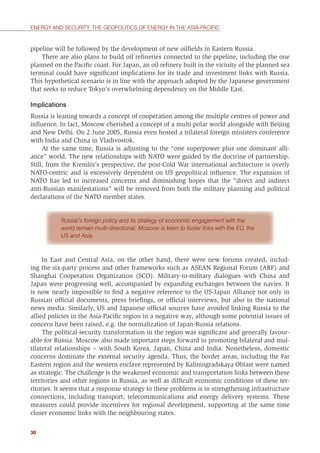




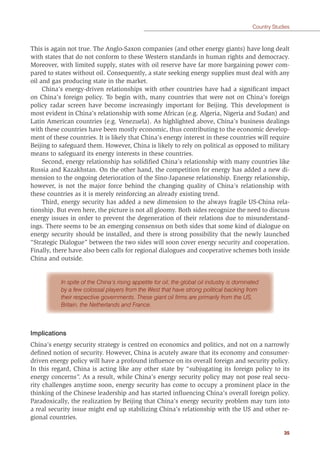
![36
ENERGY AND SECURITY: THE GEOPOLITICS OF ENERGY IN THE ASIA-PACIFIC
INDIA
by Manjeet Singh Pardesi
India is the sixth largest consumer of energy in the world, and it meets almost 30 per cent of
its energy needs through imports. Since it liberalized its economy in the early 1990s, India
has emerged as one of the fastest growing major economies in the world. Its economy has
grown at an average rate of six per cent annually since the early 1990s, and the past two years
have seen annual growth rates approaching eight per cent. At the same time, India, which
is already the second most populous nation in the world, is all set to take over China as the
largest nation in the world within the next three decades. India faces daunting challenges
in meeting its energy needs to feed its fast growing economy and to meet the human devel-
opmental goals of its rising population. Highlighting its critical importance, Prime Minister
Manmohan Singh mentioned that energy security was “second only in our [India’s] scheme
of things to food security”. To further highlight the thrust that the search for energy was pro-
viding to Indian diplomacy, PM Singh mentioned that the demands for higher growth rates
had “created new challenges for our [India’s] foreign policy in terms of seeking access to
markets, sources of energy and investment and advanced technologies”.
India’s Energy Profile
Coal is the most important source of energy for India and provides for almost 51 per cent of
the total energy consumed in the country. However, Indian coal suffers from low calorific
value and causes considerable environmental degradation as it is high in sulphur and ash.
Given its poor quality, India imports almost 25 per cent of the coking coal required by its steel
industry. However, its sheer abundance in India which is home to the world’s fourth largest
coal reserves means that it is likely to remain the principle source of energy for India until
2030 and possibly beyond.
Oil accounts for roughly 34 per cent of India’s energy consumption. India already imports
close to 65 per cent of its oil needs and its import dependency is growing fast. It is estimated
that in the worst-case scenario, almost 90 per cent of its oil consumption needs would be met
by imported oil by 2030. Natural gas accounts for 10 per cent of India’s energy consumption.
Moreover, it is fast emerging as a major alternative for India’s poor quality coal, especially for
electricity production. It is estimated that India will be dependent on imported gas for more
than 40 per cent of its total gas needs by 2030.
The remainder of India’s energy needs is provided by a mix of hydro power, nuclear
power, wind power, biomass and other non-conventional energy sources. According to a
recent study done by the Indian Planning Commission, the apex institution that formulates
India’s Five-Year Plans, even if hydro power, nuclear power and other renewable sources
were exploited to their full potential, their best possible contribution to India’s energy mix by
2030 would be around five to six per cent each.
Key Challenges
In order to meet its energy security challenges, India needs to search and tap domestic coal,
gas and oil reserves. India is likely to seek new coal extraction technologies and clean coal
technologies, both of which are available internationally to maximize the contribution of its
domestic coal reserves. India’s dependence on imported oil is likely to be acute as no major
oilfields have been discovered in India since the Bombay High fields were discovered in the](https://image.slidesharecdn.com/energyandsecurity-170324053101/85/Energy-and-security-38-320.jpg)

